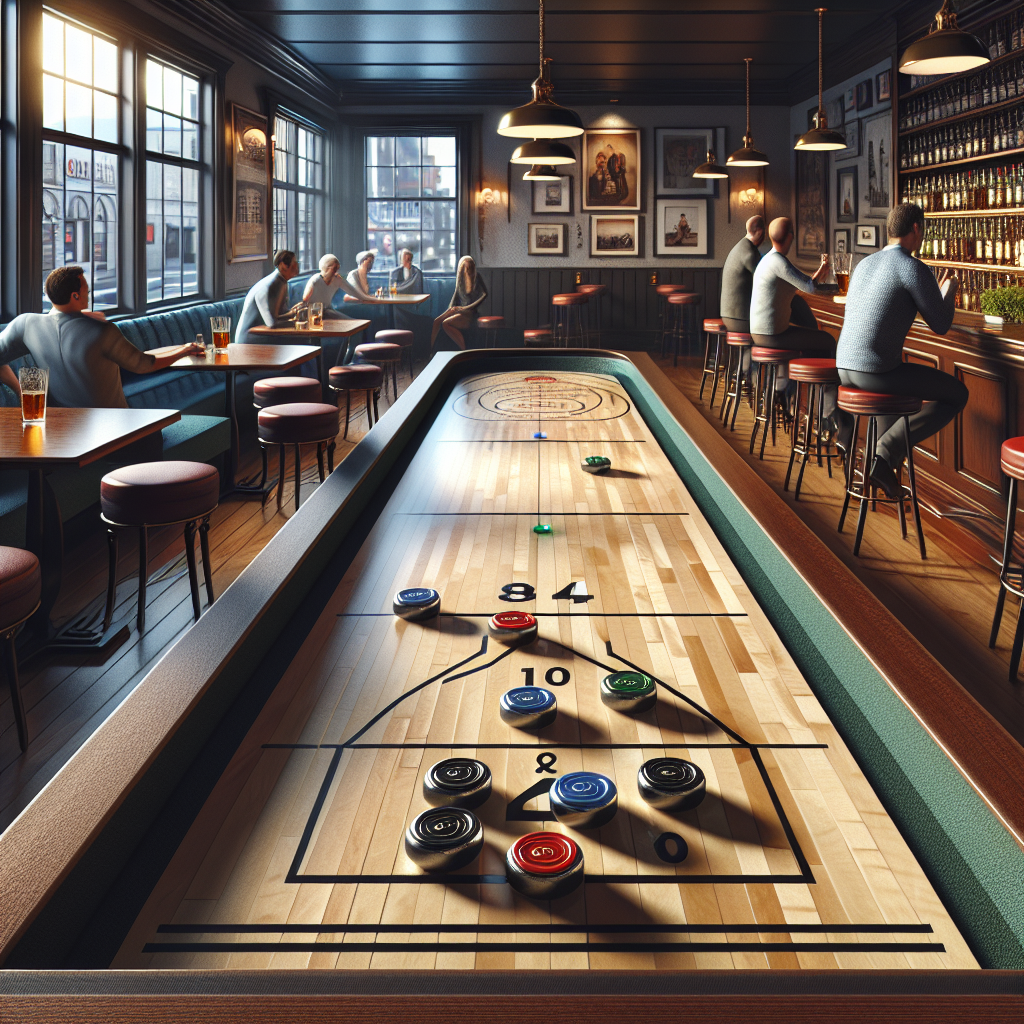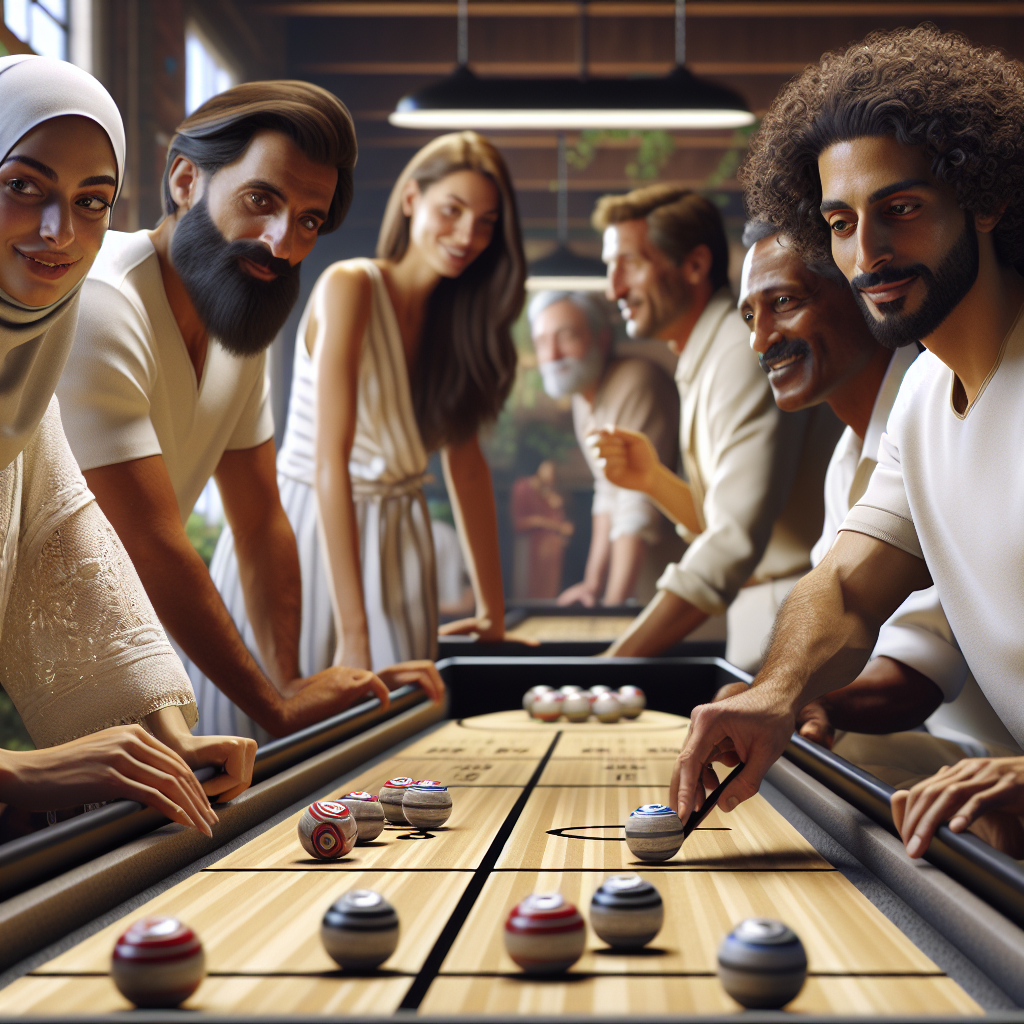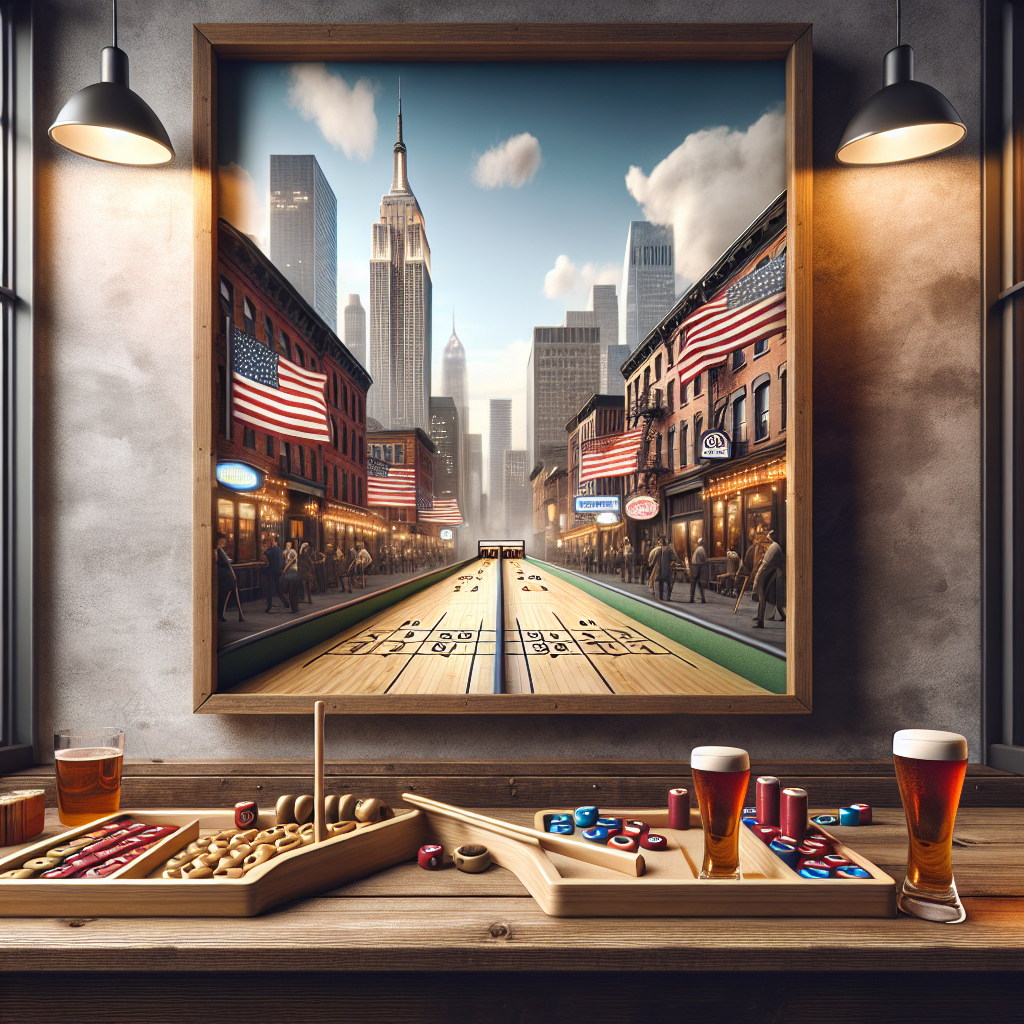Understanding Bar Shuffleboard
Bar shuffleboard is a popular game often played in lively bar settings. It combines elements of strategy, skill, and social interaction, making it a favorite pastime for many adults. In this section, we will provide an introduction to bar shuffleboard and explore the rules and variations of the game.
Introduction to Bar Shuffleboard
Bar shuffleboard is a tabletop game that originated from the traditional deck shuffleboard played on cruise ships. It has since gained popularity in bars, pubs, and recreational venues around the world. The game involves sliding weighted pucks down a long, smooth wooden table, aiming to land them in scoring zones to earn points.
One of the appealing aspects of bar shuffleboard is its casual and relaxed nature. While there are formal competitive versions of the game, bar shuffleboard is often played with “bar rules” that encourage a lively and social atmosphere. It allows for “bumpers” to protect high-scoring pucks and “hang” shots that knock off both players’ pucks, enhancing the fun and friendly competition.
The setup of a bar shuffleboard table replicates a classic rec room vibe, with a long and narrow playing surface. The dimensions of the table may vary, but it typically ranges from 12 to 22 feet in length and 20 inches wide. The playing surface is coated with a smooth finish to ensure the pucks slide smoothly across the table.
Bar Shuffleboard Rules and Variations
While bar shuffleboard has a relaxed atmosphere, it still follows a set of rules to ensure fair play and consistent gameplay. The specific rules may vary depending on the venue or the group of players, but there are common guidelines that govern the game.
Some of the basic rules include:
- Players take turns sliding pucks down the table, aiming to land them within scoring zones.
- The pucks must be released from the “foul line” at the end of the table.
- Pucks that fall off the side of the table are considered out of play.
- Only the pucks that have completely crossed the scoring zone lines are counted for points.
It’s important to note that in bar shuffleboard, there are no strict officiating requirements or penalties for rule violations. The emphasis is on having fun and enjoying the game in a social setting. The casual nature of bar shuffleboard allows for friendly banter, loud antics, and a relaxed gameplay experience.
While the basic rules remain consistent, variations of bar shuffleboard can be found depending on the location or group preferences. These variations may include additional rules or scoring options to add excitement and variety to the game.
To learn more about the dimensions of a bar shuffleboard table and how to play the game, check out our articles on bar shuffleboard dimensions and how to play bar shuffleboard.
In the next section, we will explore the scoring system in bar shuffleboard, including how points are earned and the different scoring zones on the table.
Scoring in Bar Shuffleboard
Scoring is a fundamental aspect of bar shuffleboard. Understanding how points are earned and the scoring zones is essential for playing the game effectively.
How Points are Earned in Bar Shuffleboard
In bar shuffleboard, points are earned based on the positioning of the pucks on the board. The objective is to slide the pucks as close to the scoring area as possible, while also strategically knocking off opponent’s pucks. The scoring zones and point values are determined by the distance of the pucks from the starting point.
Scoring Zones and Point Values
The scoring zones in bar shuffleboard are divided into different areas, each with its own point values. The specific point values may vary slightly depending on the rules being followed, but the general scoring system remains consistent.
Here is a breakdown of the scoring zones and their corresponding point values:
| Zone | Point Value |
|---|---|
| Closest Zone (1) | 1 |
| Middle Zone (2) | 2 |
| Furthest Zone (3) | 3 |
| Hanger (puck hanging over the edge) | 4 |
Points are tabulated based on the proximity of each player’s pucks to the far end of the board without going beyond the scoring area. It’s important to note that points only count if the pucks are not touching the line marking between zones. For example, if a puck is halfway between zones 2 and 3, the points scored would be 2, not 3 (Shuffleboard McClure Tables).
When multiple pucks are in play, only the puck furthest towards the end of the board counts for points. In the case of a tie, a T-square or visual inspection can be used to determine the puck closest to the end. If one puck is just slightly in front of the other, only the leading puck scores (Shuffleboard McClure Tables).
When a puck hangs between two zones, such as 1/2 or 2/3, the winner is determined by measuring which hanger is actually further in front of the other. This can be done through visual inspection or by using a T-square to determine the puck’s position (Shuffleboard McClure Tables).
Understanding the scoring zones and point values in bar shuffleboard is crucial for calculating scores accurately and strategizing your gameplay. By aiming for the higher point zones and strategically placing your pucks, you can maximize your score and outperform your opponents. For more information on bar shuffleboard, including rules and gameplay, check out our article on how to play bar shuffleboard.
Strategies for Bar Shuffleboard
To master the game of bar shuffleboard, players must develop effective strategies that capitalize on their opponent’s weaknesses and maximize their own scoring opportunities. In this section, we will explore three key strategies to improve your bar shuffleboard game: observing and exploiting opponent’s weaknesses, utilizing angles to score and knock off pucks, and employing various techniques and shot types.
Observing and Exploiting Opponent’s Weaknesses
A crucial aspect of shuffleboard strategy is observing and understanding your opponent’s strengths and weaknesses. By analyzing their gameplay, you can identify patterns and tendencies that can be exploited to gain an advantage. For example, if you notice that your opponent tends to overshoot, you can adjust your own gameplay by focusing on accuracy rather than power. Conversely, if they consistently undershoot, you can adjust your shots to take advantage of their weaker positioning. By forcing your opponent to play shots they are uncomfortable with, you can increase your chances of success and gain an upper hand in the game (Shuffleboard.net).
Utilizing Angles to Score and Knock Off Pucks
Another effective strategy in bar shuffleboard is utilizing angles to your advantage. By understanding the geometry of the table and the interaction between pucks, you can strategically position your shots to score points and knock off your opponent’s pucks. Aim to slide your puck at an angle that allows it to ricochet off the sides of the table, redirecting it towards the scoring zones or knocking off your opponent’s pucks. By mastering the art of angles, you can significantly improve your scoring potential and disrupt your opponent’s positioning.
Techniques and Shot Types
Developing a repertoire of techniques and shot types is crucial for success in bar shuffleboard. One technique to consider is applying English or sidespin to your shots. By imparting spin on the puck, you can control its trajectory and make it more difficult for your opponent to accurately respond. Experiment with backspin to prevent your puck from sliding off the end of the table, but be mindful not to slow it down excessively. Practice side-wheeling, a technique where you shoot from the side of the table and use the third and fourth fingers to guide the puck. This method allows for controlled shots that are risky for the opponent to knock off, particularly beneficial for keeping the puck close to the sides without falling over (Shuffleboard.net).
By combining these strategies – observing and exploiting opponent’s weaknesses, utilizing angles, and employing various techniques and shot types – you can significantly enhance your bar shuffleboard skills. Remember to adapt your gameplay based on the specific rules and dimensions of the bar shuffleboard table. With practice and a strategic mindset, you can become a formidable bar shuffleboard player, consistently scoring points and outmaneuvering your opponents.
Tips for Improving Bar Shuffleboard Skills
To enhance your bar shuffleboard skills and elevate your gameplay, consider the following tips and strategies:
Table Conditions and Compensation
Not all shuffleboard tables are created equal, and understanding the table conditions is crucial for improving your performance. Warped fields can affect gameplay, causing weights to veer off to the sides. To compensate for any curvature, players must adjust their shots accordingly. Practice and experience will help you gauge the right amount of compensation needed to keep your weights on target. For more information on bar shuffleboard rules and dimensions, refer to our article on bar shuffleboard rules and bar shuffleboard dimensions.
Grip, Stance, and Delivery Techniques
Proper grip, stance, and delivery techniques are fundamental to achieving accuracy and control in bar shuffleboard. When gripping the puck, aim for a firm but not overly tight grip. This allows you to maintain control while still being able to release the puck smoothly. Additionally, ensure that you have a balanced and stable stance before making your shot. This will help you maintain control throughout the delivery process.
To improve your delivery technique, practice a smooth and consistent release. Avoid gripping the puck too tightly, as this can result in an uncontrolled shot. Follow through with your delivery, allowing your arm to continue its motion toward the target. By mastering the grip, stance, and delivery techniques, you can enhance your accuracy and increase your chances of scoring points. For more information on improving your shuffleboard skills, refer to our article on how to play bar shuffleboard.
Developing Game Strategies
Success in bar shuffleboard often relies on strategic thinking and planning. Take the time to develop game strategies that suit your playing style and the table conditions. Understanding the board layout, anticipating your opponent’s moves, and utilizing different shooting techniques are essential elements of a winning strategy.
Observe and analyze your opponent’s strengths and weaknesses to gain a competitive advantage. Adjust your gameplay accordingly, exploiting their weaknesses and capitalizing on their mistakes. Practice different power levels and spins to enhance your control and precision during gameplay. Adapt your strategies based on the specific table and opponent you are facing.
Experiment with new techniques and shot types to keep your opponents guessing. Techniques such as applying English (sidespin) or backspin can help you control your shots and prevent your puck from falling off the table. Side-wheeling, a technique where you shoot from the side of the table using your third and fourth fingers, can yield controlled shots that are difficult for your opponent to knock off.
By continuously developing and refining your game strategies, you can improve your bar shuffleboard skills and increase your chances of victory. For more information on common mistakes to avoid, refer to our article on common mistakes in bar shuffleboard.
By implementing these tips and strategies, you can elevate your bar shuffleboard skills and enjoy a more competitive and rewarding gameplay experience. Remember to practice regularly and adapt your strategies to different opponents and table conditions.
Common Mistakes in Bar Shuffleboard
While playing bar shuffleboard, it’s important to be aware of common mistakes that can hinder success and affect gameplay. By avoiding these mistakes, players can improve their skills and increase their chances of winning. Here are three common mistakes to watch out for:
Overwhelming Force and Neglecting Strategy
One of the most common mistakes in bar shuffleboard is using overwhelming force without considering strategy. While power is important, it should be balanced with precision and control. Simply pushing the puck with excessive force may result in it flying off the table or missing the desired target. It’s crucial to find the right balance between power and accuracy to effectively score points and strategically position pucks.
Neglecting strategy is another mistake that can hinder success in bar shuffleboard. Developing a game plan and anticipating your opponent’s moves is essential. By analyzing the position of your pucks and your opponent’s pucks, you can make strategic shots that maximize your score and minimize your opponent’s scoring opportunities. Taking the time to strategize and plan ahead can greatly improve your performance on the shuffleboard table.
Defensive Play and Patience
Another common mistake in bar shuffleboard is neglecting defensive play and lacking patience. Defensive play involves taking actions to protect your high-scoring pucks and knocking off your opponent’s pucks. It’s important to be proactive in preventing your opponent from scoring points and positioning their pucks advantageously. By considering defensive strategies, you can maintain control of the game and increase your chances of winning.
Patience is key in bar shuffleboard. Rushing shots and making impulsive moves can lead to mistakes and missed opportunities. It’s important to wait for the right moment to make your move, whether it’s knocking off your opponent’s pucks or positioning your own pucks strategically. By exercising patience and staying focused, you can make calculated shots that yield successful results.
Positioning and Table Maintenance
Poor positioning and neglecting table maintenance are also common mistakes in bar shuffleboard. Positioning plays a crucial role in shuffleboard gameplay. By considering angles and using the shuffleboard table to your advantage, you can place your pucks in strategic positions that are difficult for your opponent to counter. Proper positioning requires careful observation and planning.
Neglecting table maintenance can also have a negative impact on gameplay. A well-maintained shuffleboard table provides optimal playing conditions, ensuring a smooth and consistent playing surface. Regularly cleaning and waxing the table, as well as checking for any defects or damage, is essential for maintaining the integrity of the game and preventing any disruptions during play.
By being mindful of these common mistakes and taking steps to avoid them, players can enhance their bar shuffleboard skills and improve their overall performance. Remember to strike a balance between power and precision, implement strategic gameplay, prioritize defensive play and patience, and pay attention to positioning and table maintenance. With practice and focus, you can become a master of bar shuffleboard.







